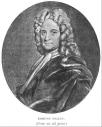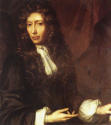Newton’s
Laws of Motion
"If
I see further than others,
it is
because I stand on the shoulders of giants."
Isaac Newton |

Isaac Newton |
Isaac Newton achieved his greatness in the annals
of science as much for validating and organizing the work of
others as for the new thinking he brought to the physics landscape. The story of how a set of rules we call Newton's
laws of motion came to exist in their present form is interesting
as much for revealing some of the quirks and biases that Newton
held as it relates the laws themselves. Newton was born on Christmas
day in 1642, the same year that Galileo died. His father
had died before he was born and when his mother remarried, Isaac
went to live with grandparents. We surmise that the loneliness
he encountered in life had its foundation in a childhood devoid
of affection from parents. He enrolled at Trinity College, Cambridge
University, and joined the faculty there upon graduation.
When the bubonic plague swept through Europe in 1665-66, the
University shut down and all faculty and students were sent home.
It was here in his garden at Woolsthorpe that the apocryphal
story of an apple falling from a tree caused him to speculate
the the force required to cause this event may be the same force
that holds the moon in place around the Earth. Despite the fact
he had uncovered a major piece of mechanics, he was content to
hold his ideas for himself; he did not publish. It was not until
eighteen years later in 1684, when approached by Edmund Halley,
that he revisited these ideas. Halley was at odds with Robert
Hooke, a powerful figure in science circles in England and,not-so-coincidentally,
the object of a bitter professional rivalry with Newton. Halley
asked Newton about the force necessary to keep one object in
orbit around the other. Newton suggested that the relationship
followed an inverse square rule; he agreed to send the proof
to Halley. The proof took two years to write and manifests itself
as Philosophiae Naturalis Principia Mathematica, the first
real physics book. Newton was instantly recognized for the genius
that he was and eclipsed all of the other scientists of his time.
By themselves, Newton's laws seem very innocuous; three short
statements, one of which is a very short equation. The laws look
pretty simple. They are in fact very powerful statements, the
fallout from which has direct bearing on you every time you move.
The analysis of simple situation to determine how Newton's laws
describe how nature behaves can often be very trying. We will
approach this analysis slowly and systematically to ensure that
you understand as we progress.
|

Edmund Halley |

Robert Hooke |
This page last edited 01/23/09
Return
to Mechanics |


